Abstract
In recent years, several studies have addressed a possible relationship between nitrate exposure and childhood type 1 insulin-dependent diabetes mellitus. The present ecologic study describes a possible relation between the incidence of type 1 diabetes and nitrate levels in drinking water in The Netherlands, and evaluates whether the World Health Organization and the European Commission standard for nitrate in drinking water (50 mg/L) is adequate to prevent risk of this disease. During 1993-1995 in The Netherlands, 1,104 cases of type 1 diabetes were diagnosed in children 0-14 years of age. We were able to use 1,064 of these cases in a total of 2,829,020 children in this analysis. We classified mean nitrate levels in drinking water in 3,932 postal code areas in The Netherlands in 1991-1995 into two exposure categories. One category was based on equal numbers of children exposed to different nitrate levels (0.25-2.08, 2.10-6.42, and 6.44-41.19 mg/L nitrate); the other was based on cut-off values of 10 and 25 mg/L nitrate. We determined standardized incidence ratios (SIRs) for type 1 diabetes in subgroups of the 2,829,020 children with respect to both nitrate exposure categories, sex, and age and as compared in univariate analysis using the chi-square test for trend. We compared the incidence rate ratios (IRRs) by multivariate analysis in a Poisson regression model. We found an effect of increasing age of the children on incidence of type 1 diabetes, but we did not find an effect of sex or of nitrate concentration in drinking water using the two exposure categories. For nitrate levels > 25 mg/L, an increased SIR and an increased IRR of 1.46 were observed; however, this increase was not statistically significant, probably because of the small number of cases (15 of 1,064). We concluded that there is no convincing evidence that nitrate in drinking water at current exposure levels is a risk factor for childhood type 1 diabetes mellitus in The Netherlands, although a threshold value > 25 mg/L for the occurrence of this disease can not be excluded.
Full text
PDF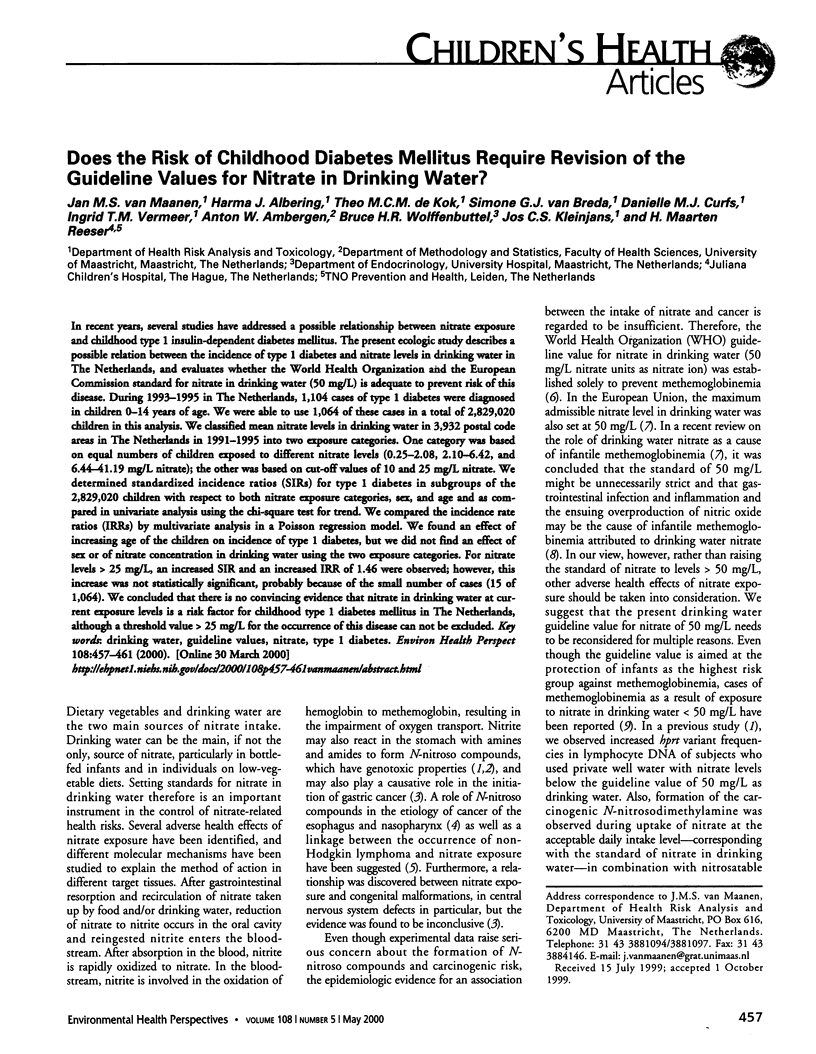
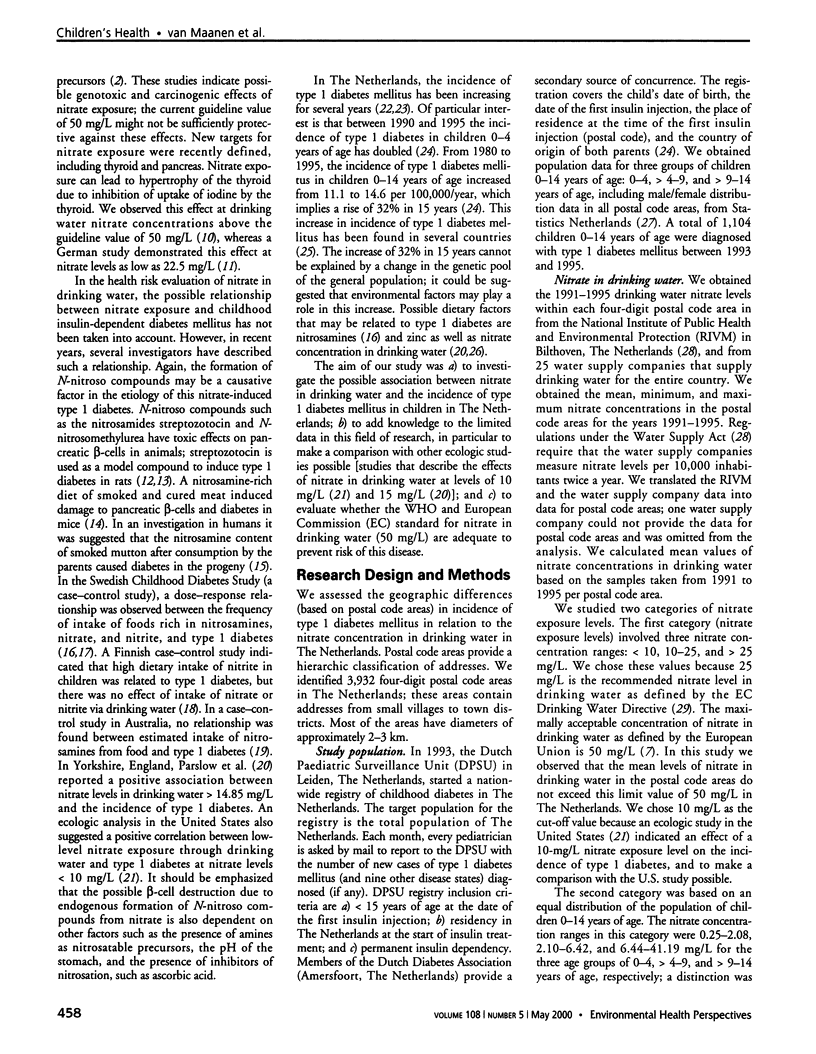
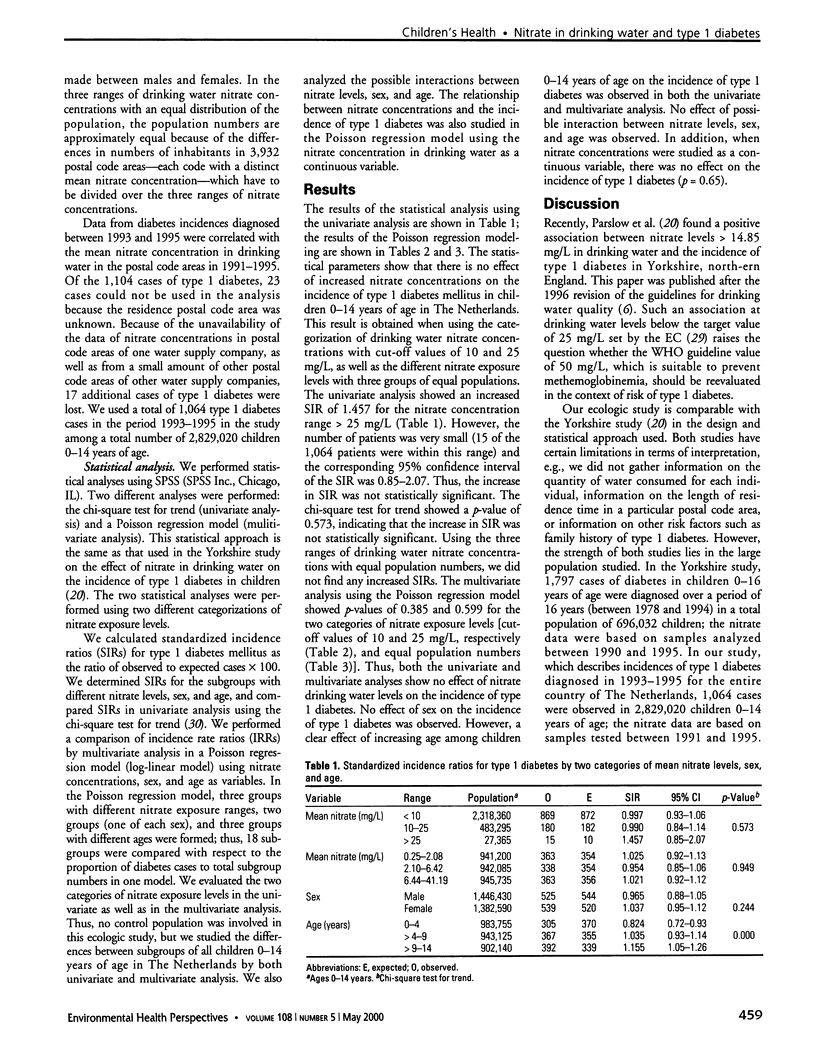
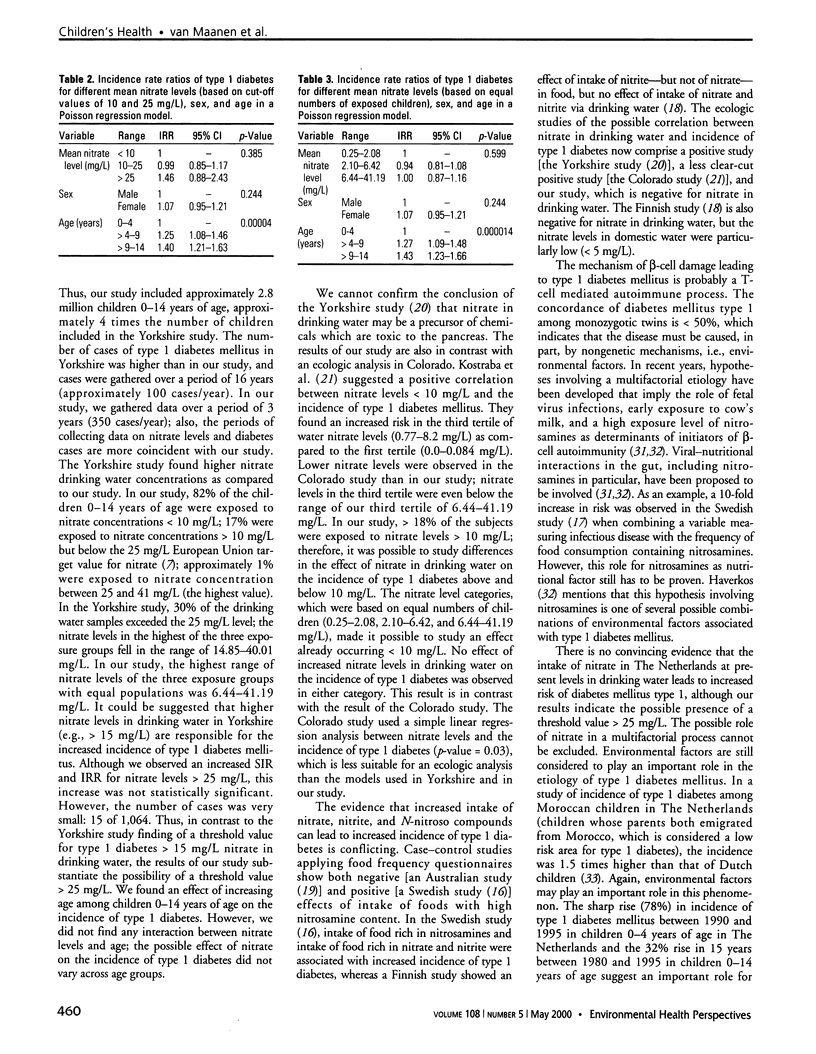
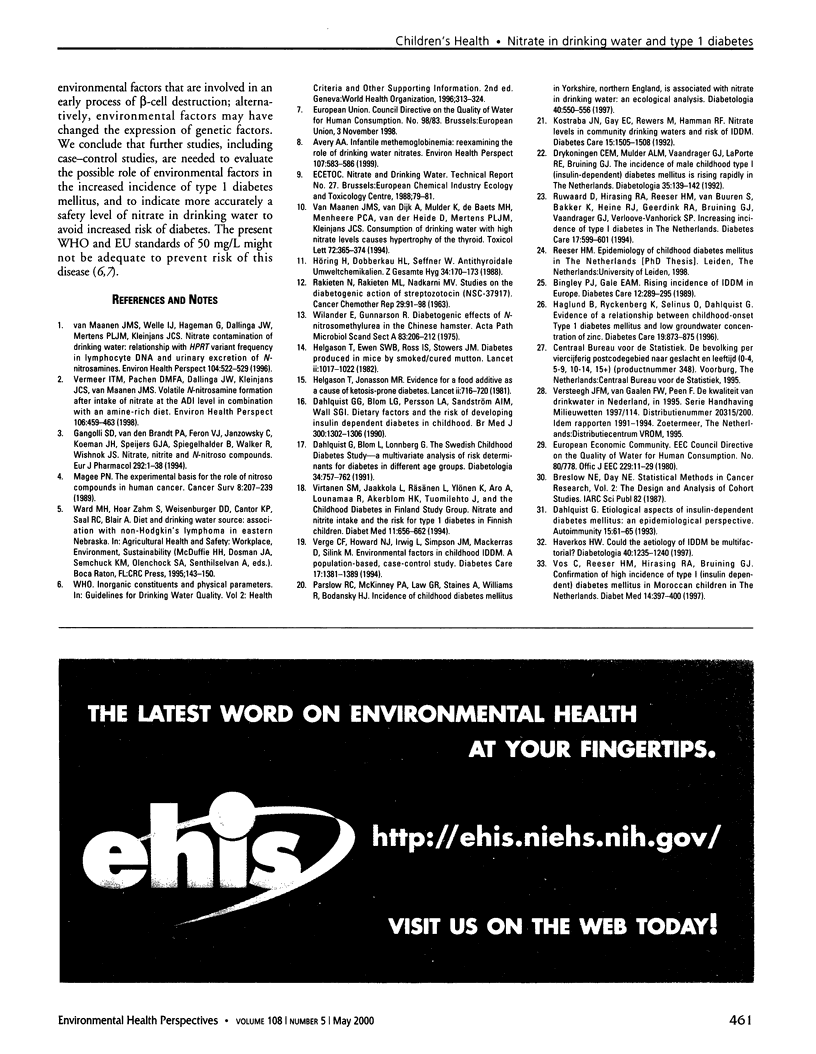
Selected References
These references are in PubMed. This may not be the complete list of references from this article.
- Avery A. A. Infantile methemoglobinemia: reexamining the role of drinking water nitrates. Environ Health Perspect. 1999 Jul;107(7):583–586. doi: 10.1289/ehp.99107583. [DOI] [PMC free article] [PubMed] [Google Scholar]
- Bingley P. J., Gale E. A. Rising incidence of IDDM in Europe. Diabetes Care. 1989 Apr;12(4):289–295. doi: 10.2337/diacare.12.4.289. [DOI] [PubMed] [Google Scholar]
- Dahlquist G. G., Blom L. G., Persson L. A., Sandström A. I., Wall S. G. Dietary factors and the risk of developing insulin dependent diabetes in childhood. BMJ. 1990 May 19;300(6735):1302–1306. doi: 10.1136/bmj.300.6735.1302. [DOI] [PMC free article] [PubMed] [Google Scholar]
- Dahlquist G., Blom L., Lönnberg G. The Swedish Childhood Diabetes Study--a multivariate analysis of risk determinants for diabetes in different age groups. Diabetologia. 1991 Oct;34(10):757–762. doi: 10.1007/BF00401524. [DOI] [PubMed] [Google Scholar]
- Dahlquist G. Etiological aspects of insulin-dependent diabetes mellitus: an epidemiological perspective. Autoimmunity. 1993;15(1):61–65. doi: 10.3109/08916939309004840. [DOI] [PubMed] [Google Scholar]
- Drykoningen C. E., Mulder A. L., Vaandrager G. J., LaPorte R. E., Bruining G. J. The incidence of male childhood type 1 (insulin-dependent) diabetes mellitus is rising rapidly in The Netherlands. Diabetologia. 1992 Feb;35(2):139–142. doi: 10.1007/BF00402545. [DOI] [PubMed] [Google Scholar]
- Gangolli S. D., van den Brandt P. A., Feron V. J., Janzowsky C., Koeman J. H., Speijers G. J., Spiegelhalder B., Walker R., Wisnok J. S. Nitrate, nitrite and N-nitroso compounds. Eur J Pharmacol. 1994 Nov 1;292(1):1–38. doi: 10.1016/0926-6917(94)90022-1. [DOI] [PubMed] [Google Scholar]
- Haglund B., Ryckenberg K., Selinus O., Dahlquist G. Evidence of a relationship between childhood-onset type I diabetes and low groundwater concentration of zinc. Diabetes Care. 1996 Aug;19(8):873–875. doi: 10.2337/diacare.19.8.873. [DOI] [PubMed] [Google Scholar]
- Haverkos H. W. Could the aetiology of IDDM be multifactorial? Diabetologia. 1997 Oct;40(10):1235–1240. doi: 10.1007/s001250050813. [DOI] [PubMed] [Google Scholar]
- Helgason T., Ewen S. W., Ross I. S., Stowers J. M. Diabetes produced in mice by smoked/cured mutton. Lancet. 1982 Nov 6;2(8306):1017–1022. doi: 10.1016/s0140-6736(82)90052-6. [DOI] [PubMed] [Google Scholar]
- Helgason T., Jonasson M. R. Evidence for a food additive as a cause of ketosis-prone diabetes. Lancet. 1981 Oct 3;2(8249):716–720. doi: 10.1016/s0140-6736(81)91048-5. [DOI] [PubMed] [Google Scholar]
- Höring H., Dobberkau H. J., Seffner W. Antithyreoidale Umweltchemikalien. Z Gesamte Hyg. 1988 Mar;34(3):170–173. [PubMed] [Google Scholar]
- Kostraba J. N., Gay E. C., Rewers M., Hamman R. F. Nitrate levels in community drinking waters and risk of IDDM. An ecological analysis. Diabetes Care. 1992 Nov;15(11):1505–1508. doi: 10.2337/diacare.15.11.1505. [DOI] [PubMed] [Google Scholar]
- Magee P. N. The experimental basis for the role of nitroso compounds in human cancer. Cancer Surv. 1989;8(2):207–239. [PubMed] [Google Scholar]
- Parslow R. C., McKinney P. A., Law G. R., Staines A., Williams R., Bodansky H. J. Incidence of childhood diabetes mellitus in Yorkshire, northern England, is associated with nitrate in drinking water: an ecological analysis. Diabetologia. 1997 May;40(5):550–556. doi: 10.1007/s001250050714. [DOI] [PubMed] [Google Scholar]
- RAKIETEN N., RAKIETEN M. L., NADKARNI M. V. Studies on the diabetogenic action of streptozotocin (NSC-37917). Cancer Chemother Rep. 1963 May;29:91–98. [PubMed] [Google Scholar]
- Ruwaard D., Hirasing R. A., Reeser H. M., van Buuren S., Bakker K., Heine R. J., Geerdink R. A., Bruining G. J., Vaandrager G. J., Verloove-Vanhorick S. P. Increasing incidence of type I diabetes in The Netherlands. The second nationwide study among children under 20 years of age. Diabetes Care. 1994 Jun;17(6):599–601. doi: 10.2337/diacare.17.6.599. [DOI] [PubMed] [Google Scholar]
- Verge C. F., Howard N. J., Irwig L., Simpson J. M., Mackerras D., Silink M. Environmental factors in childhood IDDM. A population-based, case-control study. Diabetes Care. 1994 Dec;17(12):1381–1389. doi: 10.2337/diacare.17.12.1381. [DOI] [PubMed] [Google Scholar]
- Vermeer I. T., Pachen D. M., Dallinga J. W., Kleinjans J. C., van Maanen J. M. Volatile N-nitrosamine formation after intake of nitrate at the ADI level in combination with an amine-rich diet. Environ Health Perspect. 1998 Aug;106(8):459–463. doi: 10.1289/ehp.106-1533225. [DOI] [PMC free article] [PubMed] [Google Scholar]
- Virtanen S. M., Jaakkola L., Räsänen L., Ylönen K., Aro A., Lounamaa R., Akerblom H. K., Tuomilehto J. Nitrate and nitrite intake and the risk for type 1 diabetes in Finnish children. Childhood Diabetes in Finland Study Group. Diabet Med. 1994 Aug-Sep;11(7):656–662. doi: 10.1111/j.1464-5491.1994.tb00328.x. [DOI] [PubMed] [Google Scholar]
- Vos C., Reeser H. M., Hirasing R. A., Bruining G. J. Confirmation of high incidence of type 1 (insulin-dependent) diabetes mellitus in Moroccan children in The Netherlands. Diabet Med. 1997 May;14(5):397–400. doi: 10.1002/(SICI)1096-9136(199705)14:5<397::AID-DIA358>3.0.CO;2-J. [DOI] [PubMed] [Google Scholar]
- Wilander E., Gunnarsson R. Diabetogenic effects of n-nitrosomethylurea in the chinese hamster. Acta Pathol Microbiol Scand A. 1975 Mar;83(2):206–212. doi: 10.1111/j.1699-0463.1975.tb01376.x. [DOI] [PubMed] [Google Scholar]
- van Maanen J. M., Welle I. J., Hageman G., Dallinga J. W., Mertens P. L., Kleinjans J. C. Nitrate contamination of drinking water: relationship with HPRT variant frequency in lymphocyte DNA and urinary excretion of N-nitrosamines. Environ Health Perspect. 1996 May;104(5):522–528. doi: 10.1289/ehp.96104522. [DOI] [PMC free article] [PubMed] [Google Scholar]
- van Maanen J. M., van Dijk A., Mulder K., de Baets M. H., Menheere P. C., van der Heide D., Mertens P. L., Kleinjans J. C. Consumption of drinking water with high nitrate levels causes hypertrophy of the thyroid. Toxicol Lett. 1994 Jun;72(1-3):365–374. doi: 10.1016/0378-4274(94)90050-7. [DOI] [PubMed] [Google Scholar]


